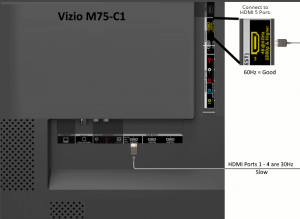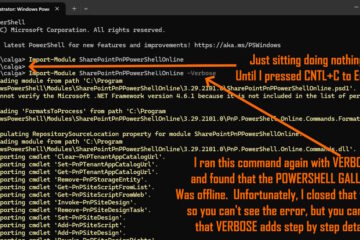This page provides the master list of the things you need to do to correct mouse lag on 4k screens.
If you have connected your PC to a 4K screen you will often see a subtle but visual notable lag between the time you move your mouse and when the pointer moves on the screen. Using 4K screens on a computer can make things difficult to control if they are not configured correctly. You can find that your mouse appears to overshoot your movements and does not respond instantly.
 There can be many causes of this problem, but in my case most of it was caused by using the wrong HDMI input on the screen. I was using a large 4K TV as a computer screen and it just was not responding quickly to my mouse movements. The solution was to move my video cable to from a standard 30Hz HDMI input to a 60Hz HDMI input. Take a look at this short video which nicely demonstrates the problem and the solution to mouse lag on 4K.
There can be many causes of this problem, but in my case most of it was caused by using the wrong HDMI input on the screen. I was using a large 4K TV as a computer screen and it just was not responding quickly to my mouse movements. The solution was to move my video cable to from a standard 30Hz HDMI input to a 60Hz HDMI input. Take a look at this short video which nicely demonstrates the problem and the solution to mouse lag on 4K.
If your PC is connected to your 4K screen at 60Hz or faster and you still see mouse lag, there are several other items to check:
- HDMI CABLE: There is a lot of discussion about the various HDMI cable standards. To clear this off your list, go buy a brand name “High Speed” HDMI 1.4 cable. See this thread for some details on 4K HDMI and this page for some suggested HDMI 1.4 products. Note that I have not found this to be a problem but others certainly have.
. - MOUSE DRIVER: Get the latest mouse driver
. - VIDEO DRIVER: Get the latest driver for your video card and make sure the video resolution is set to match the resolution of your 4K screen, usually this 3840 2160.
. - HDMI PORTS: Try connecting to different ports on both your video card and your 4K screen. As shown in the video make sure you are connecting to at least a 60Hz port on the 4K screen.
. - MOUSE DPI: Most mice scan the surface at about 800 dots per inch (DPI). High resolution 4K and even 8K screens will require a mouse that scans more to avoid lag. There is lots of information online explaining mouse scanning and DPI but it is generally considered truth that beyond about 2500 DPI claims by manufacturers are only backed up by algorithmic gymnastics that do not have much if any positive impact on real life performance. I found the Logitech G402 and G602 wireless mouse to provide absolutely no lag.
. - MOUSE SETTINGS: Make sure the mouse is set to scan at the higher resolution. High DPI mice, like those mentioned in item 5 above, do not always scan at the highest level. In an effort to save battery, manufacturers will often set a high DPI mice to scan a low DPI during normal use. This is why some people see that their mouse works fine in games but it is slow in standard Windows use. Games sometimes result in the DPI being increased automatically. Go into the driver or the mouse software and set it to 2000 DPI or above. Also note that some mice, like the G602, have a switch on the top of the mouse that toggles the mouse speed.
. - USB PORT: Connect the mouse (or mouse receiver) to different USB ports on the PC. There is talk on the internet of differences between USb3 and USB2 connections and even though I believe this makes no difference to a mouse it is worth trying alternate ports all the same.
If none of these work and you have decided that you are just going to have to live with some lag on your 4K screen, there are a few things you can do to improve your usability even with the lag:
- Enable ‘Mouse Trails’
- Set the pointer to be large and using a different colour than the typical background you are using.
- Learn to move your hand / mouse slower
- Drink more beer and try not to smash your screen in frustration



27 Comments
Nic · December 8, 2022 at 6:13 pm
Another possibility is that the video drivers may be set to 30mhz refresh rate. This was my issue with a Nvidia card. Mouse was laggy. I went into the Nvidia driver settings and the 4k monitor I was using was set to 30mhz there. When I changed it to 60mhz, the mouse worked nicely.
Noone · May 16, 2023 at 11:32 pm
Thanks, that was my issue. Intel Graphics were set to 30 Hz. Changing to 60 Hz solved it.
Idris · October 17, 2022 at 9:10 am
Tnx a lot man. Found the help I’ve needed here. Switched to Game mode and Tarah done.
Venkata · August 2, 2022 at 6:40 am
Game mode on my TV worked like a charm! Thank you all.
Douglas Gammill · May 23, 2021 at 12:10 am
I set my Roku 4k 60Hz TV to game mode. Fixed!
Andro · August 21, 2021 at 8:34 am
You actually have the good answer for me: game mode was the trick. Thx you so much, 4 years with that TV without a solution, until now 🙂
ting219t · September 11, 2021 at 7:11 am
wow after so long i do this and wha-la. ur a hero
Barti · January 16, 2022 at 2:13 pm
Thank you so much! it works for me!
Ian Matthews · January 19, 2022 at 8:31 pm
Yaaaa! Thanks for visiting and commenting Barti
Hunter M · June 29, 2022 at 5:49 pm
YES! GAME MODE worked for me too! On my Roku 4k TV I pressed the settings on the remote, went to Picture settings, then Game mode was found and turned from off to on. Solved. I thought at first it was under Picture mode > Gaming but this is not correct. Look for specifically Game mode at the menu above Picture mode settings. Good luck! THANK YOU AGAIN Mr. Gammill!
Chad Chelius · April 29, 2021 at 4:32 am
Thank you so much! I just purchased a BenQ monitor and was experiencing the lag on that monitor. It was subtle, but enough to be inconvenient. I was using SwitchRes on Mac in order to use a custom screen resolution and as soon as I picked one at 60Hz, it was snappy like I expected. Great work!
Ian Matthews · May 10, 2021 at 9:44 am
Thanks Chad. It is crazy frustrating.
Michael · April 20, 2021 at 10:13 pm
Thank you! Your reco worked on my recently bought Samsung M7 Monitor
Ian Matthews · April 21, 2021 at 9:34 am
Yaaaaaaa! Thanks for checking in Michael.
Jason · April 9, 2020 at 8:47 am
I’m at 30Hz on 4K, due to built in graphics limit, thought I was going to need video card or new computer to get normal mouse, but after your article, I looked up DPI of my mouse, which is a vertical, wired mouse, Adesso E1, and it turns out it has a DPI button I never noticed, 1 click and mouse is normal, very nice.
Pelayo · December 19, 2019 at 2:42 pm
Thank you very much !!
Maurizio · November 11, 2019 at 7:56 pm
I’ve just purchased the LG 43UM7100PLB, and there is the lag. I will try with the Game mode. :-/
Sauli Paukkonen · February 24, 2019 at 5:10 am
Changing TV to Game mode helped for me. Thanks for the article.
tibiazada · November 8, 2019 at 4:55 pm
Aqui tamém funcionou!
Eric · February 16, 2019 at 9:31 am
Koko – Thank you!!! I have an LG 4k that I’m using and this has been driving me nuts since I got it! Switched to Game mode and the lag is gone!
Clifton Taylor · January 18, 2019 at 11:35 am
One thing not mentioned in the article is that the video card must support 4k at 60Hz. I had this mouse lag problem and upon research found that my video card actually only supported 4k resolutions at 30Hz. So you may have to upgrade the video card as well.
Johannes Nagel · November 2, 2018 at 12:10 am
Good article. Solved my problem!
Thanks
Jo
Koko · September 21, 2018 at 10:34 am
Thanks for the article. I have a similar problem with my LG television. I actually tried the some if not all of their advice but it didn’t help. The solution ended up to be something much simpler. Om many TVs that are features to smooth out the video. the problem with those features is that they use a buffer, and the buffer is what creates the lag. On my television there is an option to choose a picture mode called game mode, which doesn’t do any smoothing, and eliminates the lag. You also get a much clearer picture and more true to the source. maybe you should add this to your article maybe as a first step because it’s so easy to just choose this on the television and see if the problem is gone. Glad to help.
johnbuck · July 16, 2022 at 10:42 am
I spent a couple of days trying to sort out my mouse problem, I tried most of what was suggested above but Game Mode on my LG 4k TV finally cured it. Thanks Koko!
Jason · December 4, 2017 at 8:01 am
Thank you!! I’d just upgraded my computer and plugged in the monitor to the HDMI1 input, not thinking there was a difference (Samsung 28″ UHD) and sure enough! The HDMI1 is only 30Hz. I plugged in the monitor to the HDMI2 port and it’s ready for 60Hz and now I’m back computing without the frustrating lag! Thank you! 🙂